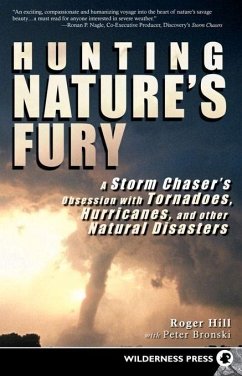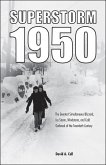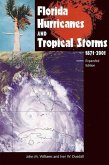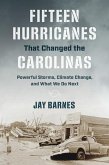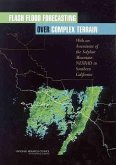Roger Hill, Peter Bronski
Hunting Nature's Fury
A Storm Chaser's Obsession with Tornadoes, Hurricanes, and Other Natural Disasters
Roger Hill, Peter Bronski
Hunting Nature's Fury
A Storm Chaser's Obsession with Tornadoes, Hurricanes, and Other Natural Disasters
- Broschiertes Buch
- Merkliste
- Auf die Merkliste
- Bewerten Bewerten
- Teilen
- Produkt teilen
- Produkterinnerung
- Produkterinnerung
Hill chronicles his love affair with storm chasing, taking readers on a suspenseful and dramatic ride across the Great Plains, into the Deep South, even into the eyes of such recent hurricanes as Katrina. Includes eight pages of photos taken by Hill showing many of the storms he chronicles in the book.
Andere Kunden interessierten sich auch für
Hill chronicles his love affair with storm chasing, taking readers on a suspenseful and dramatic ride across the Great Plains, into the Deep South, even into the eyes of such recent hurricanes as Katrina. Includes eight pages of photos taken by Hill showing many of the storms he chronicles in the book.
Produktdetails
- Produktdetails
- Verlag: Wilderness Press
- Seitenzahl: 240
- Erscheinungstermin: 5. Oktober 2009
- Englisch
- Abmessung: 214mm x 141mm x 17mm
- Gewicht: 338g
- ISBN-13: 9780899975115
- ISBN-10: 0899975119
- Artikelnr.: 26470993
- Herstellerkennzeichnung
- Libri GmbH
- Europaallee 1
- 36244 Bad Hersfeld
- gpsr@libri.de
- Verlag: Wilderness Press
- Seitenzahl: 240
- Erscheinungstermin: 5. Oktober 2009
- Englisch
- Abmessung: 214mm x 141mm x 17mm
- Gewicht: 338g
- ISBN-13: 9780899975115
- ISBN-10: 0899975119
- Artikelnr.: 26470993
- Herstellerkennzeichnung
- Libri GmbH
- Europaallee 1
- 36244 Bad Hersfeld
- gpsr@libri.de
As a professional storm chaser, Roger Hill has witnessed some 400 tornadoes and hurricanes in his lifetime and has captured them on film for every major TV network, plus National Geographic, The Weather Channel, The Discovery Channel, and The Learning Channel. He is co-owner of Silver Lining Tours, America's leading storm-chasing tour company. Peter Bronski is the author of At the Mercy of the Mountains: True Stories of Survival and Tragedy in New York's Adirondacks and the Wilderness Press guide Powder Ghost Towns: Epic Backcountry Runs in Colorado's Lost Ski Resorts.
Chapter Five: Tornado Therapy
My first tour as a guide for Silver Lining began on May 9, 2000, in
Oklahoma City. It was a ten-day tour, scheduled to conclude on May 18. I
arrived from Denver a day early to finally meet David Gold face to face.
Until that point our relationship had been restricted to emails and phone
calls.
Early on the morning of May 9, there was a knock on my hotel-room door at
the Holiday Inn near the Oklahoma City airport, our base hotel; it was
David. He greeted me in tennis shoes, shorts, and a Silver Lining Tours
T-shirt, his usual chase attire. A wide grin extended from ear to ear, and
his right hand extended out in a preemptive handshake.
I took his hand in a firm grip, thanking him for the chance to be a tour
guide on his tours. Extremely intelligent and highly proper, he articulated
each word that came from his mouth. We talked about chasing, about family
and friends, about this tour, and about our respective thoughts on the
forecast and severe-weather outlook for the next ten days of chasing.
"We're also going to be joined on this tour by National Geographic Europe,"
David explained. "They're filming a program called Twister Tours, and an
English couple with us for this tour-David and Sheila Winn-are going to be
the focus of the show." The National Geographic crew was headed up by
Executive Producer Alister Chapman, David continued. Alister had made a
name for himself as a professional cameraman and editor, producing programs
for not only National Geographic but also CNN, the Discovery Channel, and
the BBC. He ran a United Kingdom-based storm-chasing group and was even an
internationally competitive motor-rally driver in his earlier years.
Later that morning David and I walked down the hall to the Holiday Inn's
conference room, where the tour clients were all expected to gather. Bill
Reid, our driver for Van 2, was there, as were the National Geographic
crew, headed up by Alister and his Sony Betacam video camera, a huge and
expensive shoulder-mounted behemoth that ran on half-inch tapes. Alister
planned to shoot the orientation meeting.
As the clients gathered together, I soon realized that each of us in that
room chased for different reasons. Some came to get out into the wide-open
plains, where they could watch majestic supercell thunderstorms roll across
the countryside. Others came for the camaraderie, to meet other people with
the same passion, to talk about storms they've seen, and about the prospect
of storms yet to be seen. All came for the ultimate prize, the tornado.
Most people will never summit Mount Everest or swing a baseball bat on the
hallowed grounds of Yankee Stadium, or fly a fighter jet at Mach 2. But in
storm chasing anyone can experience the ultimate prize firsthand. Tornadoes
are within anyone's grasp, and the job of Silver Lining Tours-my job on
Tour 1 in 2000-was to deliver that ultimate prize safely. They, the
clients, came for different reasons, but they all shared a fundamental
goal-to see one of the most awesome and phenomenal forces on the face of
the earth and to be able to live and tell their stories of an encounter
with a tornado.
Like the clients on the tour, I had my own reasons for storm chasing. Some
of it was simply indescribable, as if the desire to chase was genetic
instinct or subconsciously imprinted in me in some way. And yet other
reasons were clear as day. Some of those reasons were linked to that
defining moment when I was nine years old in Topeka and a true monster
tornado nearly took my life. Some of my desire to chase stemmed from my
fascination with weather. And I wanted to meet the people who lived on the
plains, as I did in my youth, and hear their war stories of survival in the
face of atmospheric adversity.
But if one thing haunted me about my storm chasing, it was the death and
destruction often left in the aftermath of a tornado. It was the dark side
of the profession. People felt that storm chasers thrived on such macabre
scenes. That was never the focus for me. I chased for the beauty of the
storm and the adrenaline rush of getting close to a big tornado. I wanted
to see the storm in all its majesty, not what it left behind. But too
often, a tornado did leave something behind-a tale of lives and communities
forever changed. The good and bad of storms were thus inextricably linked.
Like a yin and yang, they coexisted and were inseparable. And every storm
chaser wrestled with balancing a storm's angels and demons.
My first tour as a guide for Silver Lining began on May 9, 2000, in
Oklahoma City. It was a ten-day tour, scheduled to conclude on May 18. I
arrived from Denver a day early to finally meet David Gold face to face.
Until that point our relationship had been restricted to emails and phone
calls.
Early on the morning of May 9, there was a knock on my hotel-room door at
the Holiday Inn near the Oklahoma City airport, our base hotel; it was
David. He greeted me in tennis shoes, shorts, and a Silver Lining Tours
T-shirt, his usual chase attire. A wide grin extended from ear to ear, and
his right hand extended out in a preemptive handshake.
I took his hand in a firm grip, thanking him for the chance to be a tour
guide on his tours. Extremely intelligent and highly proper, he articulated
each word that came from his mouth. We talked about chasing, about family
and friends, about this tour, and about our respective thoughts on the
forecast and severe-weather outlook for the next ten days of chasing.
"We're also going to be joined on this tour by National Geographic Europe,"
David explained. "They're filming a program called Twister Tours, and an
English couple with us for this tour-David and Sheila Winn-are going to be
the focus of the show." The National Geographic crew was headed up by
Executive Producer Alister Chapman, David continued. Alister had made a
name for himself as a professional cameraman and editor, producing programs
for not only National Geographic but also CNN, the Discovery Channel, and
the BBC. He ran a United Kingdom-based storm-chasing group and was even an
internationally competitive motor-rally driver in his earlier years.
Later that morning David and I walked down the hall to the Holiday Inn's
conference room, where the tour clients were all expected to gather. Bill
Reid, our driver for Van 2, was there, as were the National Geographic
crew, headed up by Alister and his Sony Betacam video camera, a huge and
expensive shoulder-mounted behemoth that ran on half-inch tapes. Alister
planned to shoot the orientation meeting.
As the clients gathered together, I soon realized that each of us in that
room chased for different reasons. Some came to get out into the wide-open
plains, where they could watch majestic supercell thunderstorms roll across
the countryside. Others came for the camaraderie, to meet other people with
the same passion, to talk about storms they've seen, and about the prospect
of storms yet to be seen. All came for the ultimate prize, the tornado.
Most people will never summit Mount Everest or swing a baseball bat on the
hallowed grounds of Yankee Stadium, or fly a fighter jet at Mach 2. But in
storm chasing anyone can experience the ultimate prize firsthand. Tornadoes
are within anyone's grasp, and the job of Silver Lining Tours-my job on
Tour 1 in 2000-was to deliver that ultimate prize safely. They, the
clients, came for different reasons, but they all shared a fundamental
goal-to see one of the most awesome and phenomenal forces on the face of
the earth and to be able to live and tell their stories of an encounter
with a tornado.
Like the clients on the tour, I had my own reasons for storm chasing. Some
of it was simply indescribable, as if the desire to chase was genetic
instinct or subconsciously imprinted in me in some way. And yet other
reasons were clear as day. Some of those reasons were linked to that
defining moment when I was nine years old in Topeka and a true monster
tornado nearly took my life. Some of my desire to chase stemmed from my
fascination with weather. And I wanted to meet the people who lived on the
plains, as I did in my youth, and hear their war stories of survival in the
face of atmospheric adversity.
But if one thing haunted me about my storm chasing, it was the death and
destruction often left in the aftermath of a tornado. It was the dark side
of the profession. People felt that storm chasers thrived on such macabre
scenes. That was never the focus for me. I chased for the beauty of the
storm and the adrenaline rush of getting close to a big tornado. I wanted
to see the storm in all its majesty, not what it left behind. But too
often, a tornado did leave something behind-a tale of lives and communities
forever changed. The good and bad of storms were thus inextricably linked.
Like a yin and yang, they coexisted and were inseparable. And every storm
chaser wrestled with balancing a storm's angels and demons.
Chapter Five: Tornado Therapy
My first tour as a guide for Silver Lining began on May 9, 2000, in
Oklahoma City. It was a ten-day tour, scheduled to conclude on May 18. I
arrived from Denver a day early to finally meet David Gold face to face.
Until that point our relationship had been restricted to emails and phone
calls.
Early on the morning of May 9, there was a knock on my hotel-room door at
the Holiday Inn near the Oklahoma City airport, our base hotel; it was
David. He greeted me in tennis shoes, shorts, and a Silver Lining Tours
T-shirt, his usual chase attire. A wide grin extended from ear to ear, and
his right hand extended out in a preemptive handshake.
I took his hand in a firm grip, thanking him for the chance to be a tour
guide on his tours. Extremely intelligent and highly proper, he articulated
each word that came from his mouth. We talked about chasing, about family
and friends, about this tour, and about our respective thoughts on the
forecast and severe-weather outlook for the next ten days of chasing.
"We're also going to be joined on this tour by National Geographic Europe,"
David explained. "They're filming a program called Twister Tours, and an
English couple with us for this tour-David and Sheila Winn-are going to be
the focus of the show." The National Geographic crew was headed up by
Executive Producer Alister Chapman, David continued. Alister had made a
name for himself as a professional cameraman and editor, producing programs
for not only National Geographic but also CNN, the Discovery Channel, and
the BBC. He ran a United Kingdom-based storm-chasing group and was even an
internationally competitive motor-rally driver in his earlier years.
Later that morning David and I walked down the hall to the Holiday Inn's
conference room, where the tour clients were all expected to gather. Bill
Reid, our driver for Van 2, was there, as were the National Geographic
crew, headed up by Alister and his Sony Betacam video camera, a huge and
expensive shoulder-mounted behemoth that ran on half-inch tapes. Alister
planned to shoot the orientation meeting.
As the clients gathered together, I soon realized that each of us in that
room chased for different reasons. Some came to get out into the wide-open
plains, where they could watch majestic supercell thunderstorms roll across
the countryside. Others came for the camaraderie, to meet other people with
the same passion, to talk about storms they've seen, and about the prospect
of storms yet to be seen. All came for the ultimate prize, the tornado.
Most people will never summit Mount Everest or swing a baseball bat on the
hallowed grounds of Yankee Stadium, or fly a fighter jet at Mach 2. But in
storm chasing anyone can experience the ultimate prize firsthand. Tornadoes
are within anyone's grasp, and the job of Silver Lining Tours-my job on
Tour 1 in 2000-was to deliver that ultimate prize safely. They, the
clients, came for different reasons, but they all shared a fundamental
goal-to see one of the most awesome and phenomenal forces on the face of
the earth and to be able to live and tell their stories of an encounter
with a tornado.
Like the clients on the tour, I had my own reasons for storm chasing. Some
of it was simply indescribable, as if the desire to chase was genetic
instinct or subconsciously imprinted in me in some way. And yet other
reasons were clear as day. Some of those reasons were linked to that
defining moment when I was nine years old in Topeka and a true monster
tornado nearly took my life. Some of my desire to chase stemmed from my
fascination with weather. And I wanted to meet the people who lived on the
plains, as I did in my youth, and hear their war stories of survival in the
face of atmospheric adversity.
But if one thing haunted me about my storm chasing, it was the death and
destruction often left in the aftermath of a tornado. It was the dark side
of the profession. People felt that storm chasers thrived on such macabre
scenes. That was never the focus for me. I chased for the beauty of the
storm and the adrenaline rush of getting close to a big tornado. I wanted
to see the storm in all its majesty, not what it left behind. But too
often, a tornado did leave something behind-a tale of lives and communities
forever changed. The good and bad of storms were thus inextricably linked.
Like a yin and yang, they coexisted and were inseparable. And every storm
chaser wrestled with balancing a storm's angels and demons.
My first tour as a guide for Silver Lining began on May 9, 2000, in
Oklahoma City. It was a ten-day tour, scheduled to conclude on May 18. I
arrived from Denver a day early to finally meet David Gold face to face.
Until that point our relationship had been restricted to emails and phone
calls.
Early on the morning of May 9, there was a knock on my hotel-room door at
the Holiday Inn near the Oklahoma City airport, our base hotel; it was
David. He greeted me in tennis shoes, shorts, and a Silver Lining Tours
T-shirt, his usual chase attire. A wide grin extended from ear to ear, and
his right hand extended out in a preemptive handshake.
I took his hand in a firm grip, thanking him for the chance to be a tour
guide on his tours. Extremely intelligent and highly proper, he articulated
each word that came from his mouth. We talked about chasing, about family
and friends, about this tour, and about our respective thoughts on the
forecast and severe-weather outlook for the next ten days of chasing.
"We're also going to be joined on this tour by National Geographic Europe,"
David explained. "They're filming a program called Twister Tours, and an
English couple with us for this tour-David and Sheila Winn-are going to be
the focus of the show." The National Geographic crew was headed up by
Executive Producer Alister Chapman, David continued. Alister had made a
name for himself as a professional cameraman and editor, producing programs
for not only National Geographic but also CNN, the Discovery Channel, and
the BBC. He ran a United Kingdom-based storm-chasing group and was even an
internationally competitive motor-rally driver in his earlier years.
Later that morning David and I walked down the hall to the Holiday Inn's
conference room, where the tour clients were all expected to gather. Bill
Reid, our driver for Van 2, was there, as were the National Geographic
crew, headed up by Alister and his Sony Betacam video camera, a huge and
expensive shoulder-mounted behemoth that ran on half-inch tapes. Alister
planned to shoot the orientation meeting.
As the clients gathered together, I soon realized that each of us in that
room chased for different reasons. Some came to get out into the wide-open
plains, where they could watch majestic supercell thunderstorms roll across
the countryside. Others came for the camaraderie, to meet other people with
the same passion, to talk about storms they've seen, and about the prospect
of storms yet to be seen. All came for the ultimate prize, the tornado.
Most people will never summit Mount Everest or swing a baseball bat on the
hallowed grounds of Yankee Stadium, or fly a fighter jet at Mach 2. But in
storm chasing anyone can experience the ultimate prize firsthand. Tornadoes
are within anyone's grasp, and the job of Silver Lining Tours-my job on
Tour 1 in 2000-was to deliver that ultimate prize safely. They, the
clients, came for different reasons, but they all shared a fundamental
goal-to see one of the most awesome and phenomenal forces on the face of
the earth and to be able to live and tell their stories of an encounter
with a tornado.
Like the clients on the tour, I had my own reasons for storm chasing. Some
of it was simply indescribable, as if the desire to chase was genetic
instinct or subconsciously imprinted in me in some way. And yet other
reasons were clear as day. Some of those reasons were linked to that
defining moment when I was nine years old in Topeka and a true monster
tornado nearly took my life. Some of my desire to chase stemmed from my
fascination with weather. And I wanted to meet the people who lived on the
plains, as I did in my youth, and hear their war stories of survival in the
face of atmospheric adversity.
But if one thing haunted me about my storm chasing, it was the death and
destruction often left in the aftermath of a tornado. It was the dark side
of the profession. People felt that storm chasers thrived on such macabre
scenes. That was never the focus for me. I chased for the beauty of the
storm and the adrenaline rush of getting close to a big tornado. I wanted
to see the storm in all its majesty, not what it left behind. But too
often, a tornado did leave something behind-a tale of lives and communities
forever changed. The good and bad of storms were thus inextricably linked.
Like a yin and yang, they coexisted and were inseparable. And every storm
chaser wrestled with balancing a storm's angels and demons.

